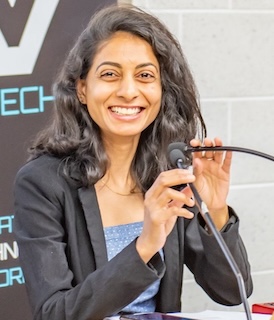Parental chromosomes separate during meiosis and segregate into sex cells, like sperm or egg, transferring genetic information to the next generation. For successful inheritance to occur, chromosomes must communicate with each other to ensure they remain intact throughout the process. Ofer Rog, who is Associate Professor of Biological Sciences at the University of Utah, employed cutting-edge genetics and high-resolution microscopy to probe local and chromosome-wide physical changes during meiosis to understand their function in chromosome inheritance.
Unraveling chromosome biology
Rog considers himself privileged to be doing science. Since he started college, he was surrounded by people who were doing research, allowing him to envision a career in academia. “I had crucial connections that helped me land a PhD position in a top-notch research institute in the UK,” says Rog. Since then, Rog has been dedicated to understanding chromosome biology.
As a PhD student in Julie Cooper’s laboratory at the University College London, Rog showed that a DNA-binding protein is required for replication forks to pass through telomeres. This was a dogma-shattering observation since the prevailing view was that DNA-binding proteins are barriers to replication. Continuing his work in chromosome biology as a postdoc with Abby Dernburg at the University of California, Berkeley, Rog embraced cell biological approaches and dissected molecular mechanisms of chromosome interactions. He first developed tools for high-resolution live imaging of chromosome dynamics in C. elegans and visualized the structure-function relationship between protein complexes that latch onto chromosomes. He provided the first direct observation of a protein network assembly onto parental chromosomes, where many proteins form a railroad-like zipper structure between parental (homologous) chromosomes to regulate exchanges during sexual reproduction. He further discovered that this structure is not static and rigid, as was widely assumed based on electron microscopy images, but rather a liquid-like dynamic compartment.
“Rog developed a cytological method to measure exchanges between sister chromatids in meiosis using pulse-chase experiments. Before his work, exchanges between sister chromatids were effectively invisible since sister chromatids are genetically identical,” explains Lisa Kursel, a Research Assistant Professor working in Rog’s laboratory at the University of Utah.
Launching his independent research group on the back of these remarkable discoveries, Rog now investigates the broader implications of the liquid-like state of the chromosomal-protein complex structure on genetic exchanges during meiosis and on cellular health. “We are interested in why the structure of the protein-chromosome complex behaves as a liquid. We hypothesize that the structure allows communication between different molecules in a very controlled way where the molecular signal diffuses inside a compartment instead of spreading to all directions at once. We are also interested in how this liquid structure can bring and hold chromosomes together to exert force on the genome and shape it into chromosomes,” says Rog. He is now combining powerful stimulated emission depletion (STED) microscopy and cryogenic electron tomography to look at molecular structures and how they manifest in the complex organization of chromosomes.
A terrific role model with a passion for science communication
Rog is the first openly gay faculty in the College of Science at the University of Utah, and he deeply values inclusion. “It is important to have visibility and have everyone’s voices heard. I have made sure to provide space for members of the LGBTQ community,” he shares. Rog used his position and influence to create changes within his research community, founding an LGBTQ+ STEM group at the University of Utah where he invites LGBTQ+ speakers to campus and discusses their inspiring research journey with students. Rog is also advocating for diversifying science along other axes as an early career researcher. “I think we currently have a lot of walls, such as people coming into a biology PhD from a non-R01 university or non-western countries. We want to hear how people in leadership positions can make science inclusive and bring down walls in the scientific community,” says Rog.
Lisa Kursel describes Rog as an excellent teacher and mentor. “His teaching and mentoring style is welcoming and inclusive. He manages to get undergraduate students excited about genetics. My undergrad mentee told me his dream is to become a genetics professor because of Rog’s influence,” says Kursel. Rog is also deeply involved in the graduate program, where he serves as an advisor on the graduate program committee.
Another of Rog’s passions is to improve science communication. As far as his research is concerned, he believes that the tools to communicate the dynamic chromosome movement are limited. “Anything you draw will look like two separate things and will not convey the dynamic nature. Static images also fail to convey that the molecules are constantly rearranging during sexual reproduction,” he explains. In coordination with Janet Iwasa, a molecular animator and Assistant Professor in the Department of Biochemistry at the University of Utah, Rog organized a conference bringing together scientists and experts in visualization technologies, such as animators, illustrators, and developers to build virtual reality platforms that communicate his work on dynamic chromosome biology. He also created an intensive fellowship writing course for graduate students to address an unmet need in formal training for science writing.
Join us in congratulating Ofer Rog, who received the Genetics Society of America Early Career Medal at The Allied Genetics Conference 2024 in Metro Washington, DC.
2024 GSA Awards Seminar Series
In a recent seminar, Ofer Rog joined us to discuss two unpublished stories from his lab–the first documenting the unexpected de-mixing of sister chromatids during meiotic prophase and the mechanisms that mediate it, and the second describing a new genomic technique his lab developed to characterize large-scale chromatin organization and its application to meiotic chromosomes. Watch the recording here!

Sejal Davla, PhD, is a neuroscientist, science writer, and data scientist with expertise in research in a variety of life sciences. She has more than a decade of experience studying the brain by using cutting-edge methodologies in microscopy, molecular biology, genetics, and biochemistry, and is a motivated storyteller and science communicator.































